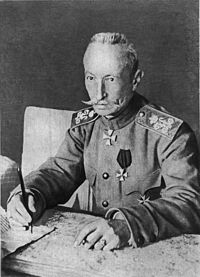Brusilov offensive
| Brusilov Offensive (Брусиловский прорыв) |
|||||||
|---|---|---|---|---|---|---|---|
| Part of the Eastern Front during World War I | |||||||
 Russian general Aleksei Brusilov, 1916 |
|||||||
|
|||||||
| Belligerents | |||||||
|
|
|
||||||
| Commanders and leaders | |||||||
|
|
|
||||||
| Strength | |||||||
| 40+ Infantry divisions (573,000 men) 15 cavalry divisions (60,000 men) |
39 infantry divisions (437,000 men) 10 Cavalry divisions (30,000 men) |
||||||
| Casualties and losses | |||||||
|
Up to 1,000,000 dead, wounded or taken prisoner Total: 500,000-1,000,000 casualties |
Austria-Hungary Total: 950,000-1,325,000 casualties |
||||||
![]() Conrad von Hötzendorf
Conrad von Hötzendorf![]() Joseph Ferdinand
Joseph Ferdinand![]() Eduard von Böhm
Eduard von Böhm
Up to 1,000,000 dead, wounded or taken prisoner
Other estimate:
440,000 dead or wounded
60,000 prisoners
500,000 total casualties
Austria-Hungary
200,000-567,000 dead and wounded
400,000-408,000 prisoners
600,000-975,000 all casualties
German Empire
350,000 all casualties
The Brusilov Offensive (Russian: Брусиловский прорыв Brusilovskiĭ proryv, lit. "Brusilov's breakthrough"), also known as the "June Advance", of June to September 1916 was the Russian Empire's greatest feat of arms during World War I, and among the most lethal offensives in world history. Historian Graydon Tunstall called the Brusilov Offensive the worst crisis of World War I for Austria-Hungary and the Triple Entente's greatest victory, but it came at a tremendous loss of life.
...
Wikipedia
